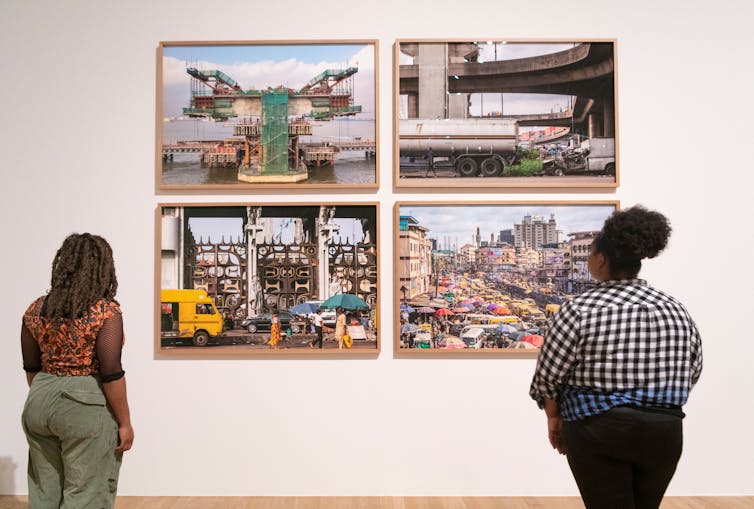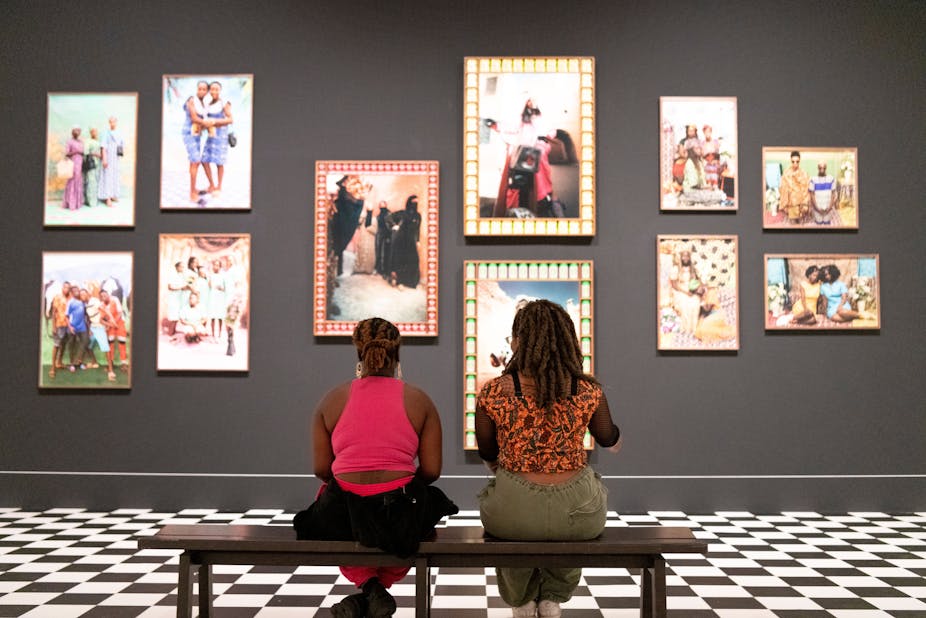The last large survey exhibition of African photography by a major western gallery was In/Sight at the Guggenheim Museum in New York in 1996. Twenty-seven years later, Tate Modern is introducing a British audience to the next generation of African photographers.
With such a long gap, there are high expectations for A World in Common: Contemporary African Photography. And the exhibition faces many curatorial challenges.
For most British visitors, this exhibition serves as an enlightening journey that challenges their perspective. It confronts and dismantles enduring colonial stereotypes associated with Africa. Simultaneously, it stands as a long-awaited affirmation of African photographers, validating their unique use of the medium.
The show’s curator, Osei Bonsu, developed three major themes – “identity and tradition”, “counter histories” and “imagined futures”. The 36 featured photographers tell stories of a new and confident Africa. It’s an Africa that celebrates its spirituality and is untangling itself from its colonial past. This is awe-inspiring work, by a new generation of artists who draw on the rich social and political history of the continent to tell their stories.
When entering the exhibition, I was immediately taken in by a series of large portraits: Nigerian Monarchs by George Osodi. The formality of the images speaks to the importance of these rulers as custodians of cultural heritage – even though their powers were eroded during British colonial rule.
The portrait of Obi Anyasi II, the longest reigning African king, is a clever comment on Nigeria’s past. His stern gaze competes with that of Queen Elizabeth II, whose portrait is printed on his gown. In the exhibition catalogue, Osodi explains that documenting and archiving culture is “key to understanding cultural origins, and thus developing a sense of identity”.

In the same room is Zimbabwean artist Kudzanai Chiurai’s series We Live in Silence. These works are a reminder that Christian missionaries contributed to the colonial occupation of the continent and were instrumental in dismantling pre-colonial societies, in which women had often been powerful and influential figures.
Inspired by Bible scenes, Chiurai’s work focuses on modern African women. He reclaims their space in the historic narrative of the continent.
At the same time, female artists are still struggling to claiming their space in the exhibition as only 12 women featured. Gender balance should have been a fundamental consideration in the curation of this exhibition, as it is crucial to foster equal representation of African women in the arts.
Dialogue and consent
Wura-Natasha Ogunji’s work stood out as the only piece in the show that documented a response from Africans and engaged the African audience directly.
In her performance video, Will I Still Carry Water When I Am a Dead Woman? a group of masked women drag golden water canisters through the busy streets of Lagos, Nigeria. The reactions of the local people underscored art’s potential to challenge the undervaluing of female labour. It provokes dialogue where performance art is not widely understood or appreciated.
Ogunji, born in Nigeria, received her BA from Stanford University and an MFA from San Jose State University in the US. This highlights yet another issue with the roster of photographers in the exhibition. A considerable number have well-established ties with European and American art institutions.
Also, a significant portion have pursued their studies in Europe and the US, are represented by international galleries and maintain a dual presence between two continents. They are part of the global art scene that sees African art as a growing investment opportunity. There’s a risk that will result in the best examples of African art leaving the continent. As French gallery owner Cécile Fakhoury has observed: “If we keep going as we are, in ten or 20 years we will see all the major pieces in foreign countries.”
As this intensifies, it perpetuates a resource vacuum for local artists solely residing and working in Africa. It highlights the continuous underfunding of the cultural sector by most African governments and the lack of globally recognised art institutions on the continent.
Sadly, Tate Modern has missed a trick here. It could have more purposefully supported and celebrated the creation of local African art and included material that challenged its own position (as well as that of other western art institutions) in the global art market. As it is, I am provoked to think that A World in Common is a European exhibition with African content, rather than an exhibition that invites uncomfortable conversations about the function of institutions in the effort to decolonise our understanding of African art.

In the final two rooms, artists are imagining futures for Africa. Kiripi Katembo’s beautiful photographs of Kinshasa reflected in rainwater puddles capture urban life through a surreal mirror. Andrew Esiebo’s large images create a momentary stillness in the ever-changing architecture and landscape of Lagos. They comment on the “endless juxtapositions that exist in the city, between past and present, modernity and tradition”, as Esiebe observes in the catalogue.
What struck me most about the exhibition was the consent implicitly and explicitly expressed in all the works by collaborating with the sitters and avoiding works created through covert observations.
By working with masks, mirrors, self-portraiture or consenting sitters, the featured artists all circumnavigate the historic and often still-present exploitative relationship between the camera and the African continent. This is a decolonial approach to photography we can all learn from, but it also poses the question of how African photographers will make visible the richness of everyday life on the continent.
On the epilogue text panel, Senegalese writer and academic Felwine Sarr calls for “Africans to think and formulate their own future”. The 36 exhibiting artists definitely do that. But the curatorial challenges are manifold. My observations are an attempt to move the conversation beyond the thought-provoking work of the photographers and towards challenging the role of Tate Modern.
A World in Common: Contemporary African Photography is on at the Tate Modern until January 4 2024.

Looking for something good? Cut through the noise with a carefully curated selection of the latest releases, live events and exhibitions, straight to your inbox every fortnight, on Fridays. Sign up here.

